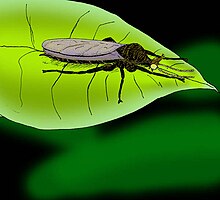Cascoplecia
Appearance
| Cascoplecia Temporal range:
| |
|---|---|

| |
| holotype fossil | |
| Scientific classification | |
| Kingdom: | |
| Phylum: | |
| Class: | |
| Order: | |
| Infraorder: | |
| Family: | † Cascopleciidae Poinar Jr., 2010
|
| Genus: | †Cascoplecia Poinar Jr., 2010
|
| Species: | †C. insolitis
|
| Binomial name | |
| †Cascoplecia insolitis Poinar Jr., 2010
| |
Cascoplecia insolitis, commonly known as the unicorn fly,[1] is an extinct dipteran that lived in the Early Cretaceous. The type specimen was found in Burmese amber.[1] George Poinar, Jr., who described this fossil, coined a new family name for it – Cascopleciidae. One of the defining characteristics of Cascoplecia is the presence of three ocelli raised on an extended, horn-like protuberance (hence its common name). Its distinctiveness has been questioned by other authors, who suggest that the taxon is simply an aberrant member of the Bibionidae.[2]

References
- ^ a b Poinar Jr., George (2010). "Cascoplecia insolitis (Diptera: Cascopleciidae), a new family, genus, and species of flower-visiting, unicorn fly (Bibionomorpha) in Early Cretaceous Burmese amber". Cretaceous Research. 31 (1): 71–76. doi:10.1016/j.cretres.2009.09.007.
- ^ Thomas Pape, Vladimir Blagoderov & Mikhail B. Mostovski. 2011 Order DIPTERA Linnaeus, 1758. In: Zhang, Z.-Q. (Ed.) Animal biodiversity: An outline of higher-level classification and survey of taxonomic richness.
